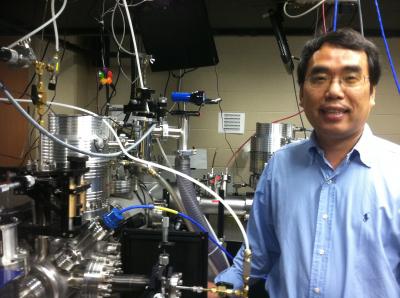Ultrafast laser technique developed to observe electron action

This is Zheng Chang in his lab at UCF. Credit: UCF
This time, Chang and his team have developed a new ultrafast light source for observing electron motion in molecules – made up of nuclei and electrons – at the point before the nuclei start to move. By being able to observe what actually happens, scientists can begin to understand how an electron interacts with other electrons, which may help improve the efficiency of solar cells.
“The charge migration that theorists have been predicting since 1999 happens so quickly we haven't been able to observe it yet,” Chang said. “It's very exciting, because we have found a new way to build light sources that may allow us to see it in the future.”
Being able to see this superfast interaction between electrons gives scientists another tool to unlock the rules that govern the quantum-mechanics world – a world where microscopic objects don't obey the laws of physics we have come to rely on for understanding in the macro world.
So how did Chang and his team manage to develop the new light source? The team borrowed an idea from Chang's earlier innovative work in the area of ultrafast lasers.
“We control the below-threshold harmonic light emission by using electromagnetic fields with time-dependent ellipticity, like we have done to the above-threshold high-order harmonics,” said Chang referring to the creation of a 67-attosecond pulse of extreme ultraviolet light, which earned him international recognition. “We thought: Could we use the same gating fields to show the dependence of the below-threshold harmonic intensity on the carrier-envelope phase of the driving laser? It took us some time to find the right experimental parameters, but the answer is yes.”
The result of his study “Coherent phase-matched VUV generation by field-controlled bound states” appears this week in Nature Photonics.
Chang has been studying light and ultrafast lasers his entire career. This past year UCF established the Institute for the Frontier of Attosecond Science and Technology (FAST). The institute is a collaboration between experts and students in UCF's College of Optics and Photonics (CREOL) and the College of Sciences' physics department to focus on this field of science.
Co-authors include: Michael Chini, Xiaowei Wang, Yan Cheng, Yi Wu and Eric Cunningham from UCF's FAST; Peng-Cheng Li, John Heslar and Shih-I Chu from the Center for Quantum Science and Engineering and the Department of Physics at the National Taiwan University; He Wang from the Materials Sciences Division at the Lawrence Berkeley National Laboratory, and Dmitry A. Telnov from the Department of Physics at St. Petersburg State University in Russia.
“It was truly a collaborative effort,” Chang said. “And there are certainly commercial applications. We're talking about cutting-edge lasers with potential application in electronics, navigation, communications and medicine.”
Chang said he is excited about the new work because he hopes it will help lead to bigger and greater discoveries.
“My dream is to discover new physics that has not been predicted at this time,” Chang said. “Until there was a microscope, we had no idea how complicated, how amazing cells were. What we are creating now are tools for magnifying time in order to discover what we have not even imagined yet. That's what I see for the future of our field.”
The Defense Advanced Research Projects Agency, National Science Foundation, U.S. Department of Energy, National Science Council of Taiwan and National Taiwan University funded the research.
America's Partnership University: The University of Central Florida, the nation's second-largest university with nearly 60,000 students, has grown in size, quality, diversity and reputation in its first 50 years. Today, the university offers more than 200 degree programs at its main campus in Orlando and more than a dozen other locations. UCF is an economic engine attracting and supporting industries vital to the region's future while providing students with real-world experiences that help them succeed after graduation. For more information, visit http://today.ucf.edu.
Media Contact
All latest news from the category: Physics and Astronomy
This area deals with the fundamental laws and building blocks of nature and how they interact, the properties and the behavior of matter, and research into space and time and their structures.
innovations-report provides in-depth reports and articles on subjects such as astrophysics, laser technologies, nuclear, quantum, particle and solid-state physics, nanotechnologies, planetary research and findings (Mars, Venus) and developments related to the Hubble Telescope.
Newest articles

Machine learning algorithm reveals long-theorized glass phase in crystal
Scientists have found evidence of an elusive, glassy phase of matter that emerges when a crystal’s perfect internal pattern is disrupted. X-ray technology and machine learning converge to shed light…

Mapping plant functional diversity from space
HKU ecologists revolutionize ecosystem monitoring with novel field-satellite integration. An international team of researchers, led by Professor Jin WU from the School of Biological Sciences at The University of Hong…

Inverters with constant full load capability
…enable an increase in the performance of electric drives. Overheating components significantly limit the performance of drivetrains in electric vehicles. Inverters in particular are subject to a high thermal load,…





















